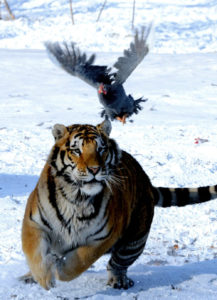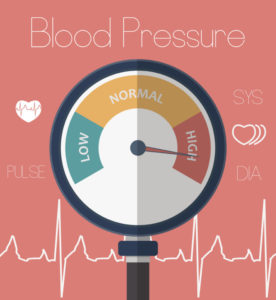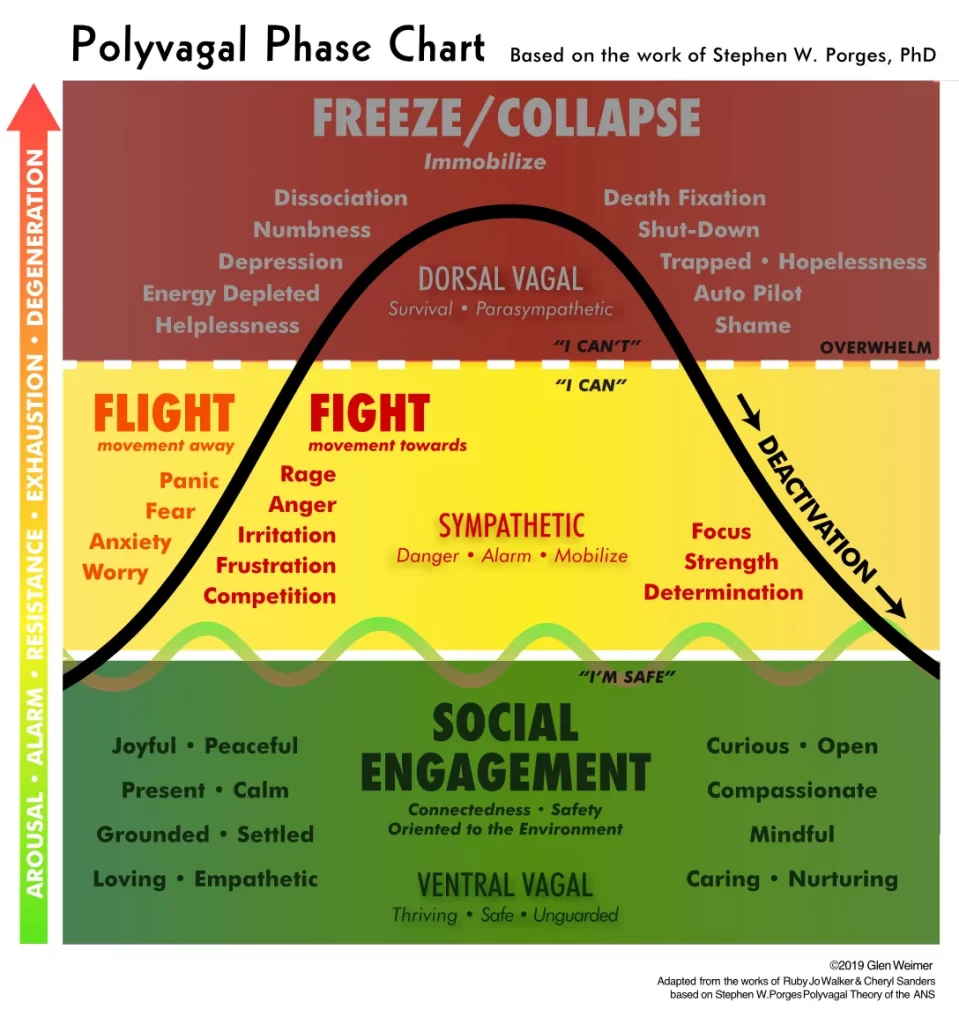Please note: this is the fourth of a 5-part blog. (see Parts 1, 2 & 3)
Sympathetic Nervous System • Danger
In Part 4 we will examine the Sympathetic Nervous System (SNS): how it mobilizes our BodyMind System (BMS) into Fight or Flight, its role in childhood development, as well as healthy and unhealthy expressions.
The SNS is our mobilization response to external stimuli. It is neither inherently good nor bad. It is a powerful energetic, electromagnetic charge that builds within our nervous system and is released through an explosion of action, like a coiled spring suddenly released. It developed through evolution to ensure our survival. It’s our ORANGE LIGHT / Danger Mode!
Childhood SNS Condtioning
All of childhood is designed to train us to navigate between Sympathetic activation and Ventral Vagal (VVC) safety. This process begins shortly after birth with the first game every parent plays with their newborn, peekaboo. Infants delight and literally can’t get enough of this simple ubiquitous game. It stimulates Sympathetic activation within a context of safety that entrains the child’s nervous system to associate SNS activation with FUN.
As we grow, peekaboo gives way to hide-and-seek, then red rover, dodge ball, and even board games. We continually increase the levels of intensity always within a framework of fun and safety; fostering a healthy neurological flow between activation/mobilization and calm/rest. Our formative years establish our deep ANS programming that determines our ‘go-to’ responses to external stimuli.
Solitary active play like climbing, running, biking, skateboarding, all help us hone this activation/down-regulation skill, but can lack the social aspect which brings us fully into Ventral Vagal interconnectedness.
 As we get older, group activities and team sports in particular help cultivate a robust ANS regulatory response (resilient vagal tone), taking us from being knocked to the ground to then being offered a helping hand back up. We get maximum benefit from conditioning fluid neurological switching while engaging socially with others.
As we get older, group activities and team sports in particular help cultivate a robust ANS regulatory response (resilient vagal tone), taking us from being knocked to the ground to then being offered a helping hand back up. We get maximum benefit from conditioning fluid neurological switching while engaging socially with others.
For many of us however, childhood was not that idilic. We may have been teased, bullied or even abused; where the impulse to fight or run was not a viable option. We never developed the skill of fluid ANS regulation or to associate mobilization with fun. Instead of mobilizing our SNS we either developed frustrated Sympathetic patterns or dropped into our Dorsal Vagal (DVC)/Parasympathetic NS and froze or collapsed. We will explore this more fully in part 5.
The Body’s Response
The SNS activates numerous biological systems that are in many ways opposite to our Parasympathetic NS. It’s like every switch that was turned on is now turned off and vice versa. The SNS was designed to keep our primitive ancestors alive in the face of impending danger.
 Biological changes start in the brain, where blood is drawn away from the neocortex to the limbic-hypothalamic-pituitary-adrenal axis for instinctual response. We become hyper-vigilant. There is no time to contemplate options, immediate action is required!
Biological changes start in the brain, where blood is drawn away from the neocortex to the limbic-hypothalamic-pituitary-adrenal axis for instinctual response. We become hyper-vigilant. There is no time to contemplate options, immediate action is required!
The adrenal glands secrete activation and stress hormones; the pancreas secretes insulin; digestion and other ‘non-essential’ body functions are put on hold; the lungs dilate and the heart races; and blood is shunted away from our core, out to the big muscle groups of our limbs, neck, and shoulders.
Other bodily responses to SNS activation include a grim or focused facial affect, monotone or strained voice, avoidance of direct eye contact, and our hearing is tuned to detect predatory sounds (very high or low frequencies, very loud or soft noises). There is an increase in blood pressure as well a blood clotting (for wound repair), and a decrease in our immune response. On the up side, it decreases fat storage since we are burning it to fuel increased energy needs.
SNS In Distress
Neuroception is continually scanning our environment for indications of danger, but when it finds it there’s a hitch. The problem is two-fold, firstly our BMS errs on the side of overprotection and secondly our autonomic state is self-reinforcing. So, if we feel safe, we sense more safety, but if we feel threatened, we see threats everywhere.
 Our autonomic state literally colors our perception of reality. When we are in VVC everyone is smiling, happy, friendly and loves us. When our SNS activates the world is an ominous place, even smiling people seem to be scowling. We interpret all interactions as threatening. It shifts our perceptions of color, sounds, smells and tastes.
Our autonomic state literally colors our perception of reality. When we are in VVC everyone is smiling, happy, friendly and loves us. When our SNS activates the world is an ominous place, even smiling people seem to be scowling. We interpret all interactions as threatening. It shifts our perceptions of color, sounds, smells and tastes.
The SNS state is meant to be an instant involuntary response to an imminent threat. Unfortunately, we are using the same response that served us well in the jungle to meet our modern world challenges. More specifically, the problem is that we often don’t feel like we can act, so the SNS is continuously engaged in a frustrated Flight or Flight pattern.
The nervous system is holding onto an energetic charge causing the body to sustain a persistent tension of Fight in the upper body when we’d love to ‘punch somebody’s light out’ but hold back for legal, moral and ethical reasons. We hold on to the Flight response in low back, psoas, butt and leg tension when we can’t run away from our problems.
TMJ or jaw tension is another place the Fight response gets stored. Instead of doing battle with our fists, jaw tension is where we bite back a war of words. It suppresses that roar of frustration when we really want to give someone a piece of our mind but can’t or won’t.
Longterm Frustrated SNS
Moreover, when we live in continual Sympathetic activation our body maintains all of these physiological charges, like elevated heart rate, blood pressure, hyper-vigilance and impaired cognition; which has far-reaching adverse affects on our health.
This frustrated SNS pattern feels like we have one foot on the gas petal, the other on the brake. Our engine is revving but that charge has nowhere to go. An unexpressed Flight response leads to a racing mind and emotions of worry, anxiety, fear and panic. Whereas a thwarted Fight response creates feelings of frustration, irritation, anger, and ultimately rage.
“We live a story that originates in our autonomic state,
is sent through autonomic pathways from the body to the brain,
and is then translated by the brain into the beliefs that guide our daily living.
The mind narrates what the nervous system knows. Story follows state.”
Deb Dana, The Polyvagal Theory in Therapy
 A ‘Type-A personality’ can be understood as a lifelong maladaptation to the perception of an adversarial world. We are constantly on guard, hyper-vigilant in anticipation of what might happen. Our need to control every aspect of our life can manifest in hypertension and ‘anal retentiveness’. When the tiger is about to pounce, there’s no time to go to the bathroom, or sleep for that matter. What was designed as a temporary state has become a way of life.
A ‘Type-A personality’ can be understood as a lifelong maladaptation to the perception of an adversarial world. We are constantly on guard, hyper-vigilant in anticipation of what might happen. Our need to control every aspect of our life can manifest in hypertension and ‘anal retentiveness’. When the tiger is about to pounce, there’s no time to go to the bathroom, or sleep for that matter. What was designed as a temporary state has become a way of life.
Sensory & Motor Patterns
Polarity Therapy founder, Dr. Randolph Stone spoke of two types of electromagnetic neurological pathways in the body: Sensory and Motor Currents, (Afferent and Efferent respectively.) What we have been talking about are primarily frustrated Motor Current energies, a disruption in the signal from the brain to the body. The issue lies in a pent-up ANS charge that doesn’t get discharged through action.
Sensory Current issues, on the other hand, come when we reject our thoughts, feelings or the actions that arise from a dysfunctional relationship with our SNS. The conflict here is from the body back to the brain. We internalize and suppress emotions such as anger, frustration and anxiety; or we cannot internally reconcile our own actions or inactions in the face of threat. We might blame ourselves if we didn’t/couldn’t act or berate ourselves for things we did which in hindsight we deeply regret. These might have been expressed as deceitful, manipulative, passive aggressive or even abusive responses. We often develop these tactics in childhood as acquired behaviors.
The build-up of Sympathetic charge within us can be extremely intense, ‘screaming’ for release. So we can justify anything to ourselves, because only through an energy discharge can we return to some level of Ventral Vagal normalcy. The process is energetic and physiological first; only afterward is the ‘fall-out’ psycho-emotional as we paint the picture of how we want to remember events, which forms our self-image and ego. As Deb Dana says, “Story follows state”.
This internal war with ourselves becomes lodged in our tissue field. It warps the shape of our body through muscular tension and organ dysfunction patterns. It’s important to clarify that I am not advocating that we hit our kids or yell at our bosses, but we must develop healthy strategies to safely and appropriately discharge this built-up Sympathetic charge in order to live happy lives in vibrant bodies.

SNS In Health
When we’ve nurtured a Ventral Vagal tone of safety, security and interconnectedness; and when we’ve conditioned ourselves to fluidly shift between SNS and VVC; then we can utilize our Sympathetic state to enrich our lives in extraordinary ways.
 SNS focuses us to achieve goals and motivates us to overcome obstacles. We draw strength and determination from it, and in partnership with VVC, it enables us to accomplish group objectives. We delight in our ability to play, create, compete, dance, and engage in sports. Safe interaction with others also allows for intimate contact, sensuality and sexuality.
SNS focuses us to achieve goals and motivates us to overcome obstacles. We draw strength and determination from it, and in partnership with VVC, it enables us to accomplish group objectives. We delight in our ability to play, create, compete, dance, and engage in sports. Safe interaction with others also allows for intimate contact, sensuality and sexuality.
Seamless co-regulation between VVC and SNS just makes life better! It produces a kind of hybrid state that provides us with the best of both worlds. People with a co-regulated SNS revel in the excitement of each new challenge. Like everything, it’s easier to do when we start young, but we can build this skill at any time in life.
Therapy & the SNS
Whether they know it or not, most of my clients come to me or seek out other therapies, primarily for issues stemming from ANS dysfunction. SNS distress locks into the tissue field as chronic persistent tension in the muscles; and distortions of intrinsic organ movements create impaired body functions. It also produces lifelong and acute psycho-emotional distress. (We will cover DVC patterns in therapy separately in part 5.)
There are numerous methods for assisting the BMS to co-regulate to VVC safety. Many verbal body-centered trauma techniques have emerged out of an understanding of the Polyvagal ANS designed to help the system discharge the charge and return to a peaceful homeostasis. There are also bodywork techniques that address these distortion patterns in the tissues and body-mind connection.

During a session when I make contact with a body that is holding frustrated Sympathetic patterns, my impression is that it is primed to do battle. Sometimes it’s been waiting for this fight for years. When I push on the tissues, there is either no give, like a brick wall, or a push back against my hand as the muscles and organs go into deeper contraction—they dig in for the fight.
The key is to recognize the wisdom of this defense mechanism. It is there for a reason. It is what prevented the system from going into overwhelm and collapsing. Unfortunately, a perpetual perception of danger/threat now keeps these tissues hyper-vigilant. I understand that behind this ‘fortress’ there is often the terrified child or younger self who constructed that wall for self-protection.
The last thing I want to do is force my way in, even though it’s very tempting. It is easy to overpower muscles into submission, and often the client just wants someone to break through and give them relief. Unfortunately, when we do, it’s a boundary violation. The tissues aren’t really relaxing, they are surrendering to Dorsal Vagal collapse. This violation can create new secondary patterns of SNS tension or DVC freeze within the tissue field. Regrettably, that is the approach of many bodywork therapies. When this happens clients have the experience that after the session their muscles ‘double-down’, and they are in even more pain.
Using the Polyvagal model as a guide, you can see that the goal is to help the system navigate back to Ventral Vagal safety and interconnectedness. This requires a touch that is as soft, gentle, and as encouraging as possible; never overwhelming the system with intense pain but rather working within a pain-free or mild-discomfort range where the client’s body can begin to relax.
Another challenge is that Autonomic states are self-reinforcing, so the psyche and body-consciousness are locked into a perception of threat. It is therefore often necessary to meet the tension in the field with a momentary matching firm touch. The BMS interprets this as finally getting the fight it’s been waiting for. I can then begin to relax my contact and the tissue field softens in-kind. I continue to walk us back from this confrontation, softening and softening. As I do, the client’s subconscious system gets the realization “there is no battle here” and down-regulates back to VVC. Together we co-regulate and retrain the system to experience safety and to dissipate the SNS charge.
The body is pleading for a witness to its pain and its story,
once seen everything changes!
Exercise 1
 Shake! Shaking helps to discharge the built-up charge from the nervous system. Somatic Experiencing founder, Peter A. Levine, PhD uses the example of a deer grazing in a field to illustrate this. As soon as a deer hears a noise its head springs up and it become hyper alert (the Sympathetic branch of the ANS is activated—Fight or Flight). The deer is poised to bolt. If it doesn’t find a threat, before it returns to grazing it will tick or shake it off, discharging that build up of nervous system energy from its whole body.
Shake! Shaking helps to discharge the built-up charge from the nervous system. Somatic Experiencing founder, Peter A. Levine, PhD uses the example of a deer grazing in a field to illustrate this. As soon as a deer hears a noise its head springs up and it become hyper alert (the Sympathetic branch of the ANS is activated—Fight or Flight). The deer is poised to bolt. If it doesn’t find a threat, before it returns to grazing it will tick or shake it off, discharging that build up of nervous system energy from its whole body.
You can shake your whole body or release the tension from one specific area. Use your discretions to determine what is appropriate for your body. It can be subtle, gentle and rhythmic or vigorous and erratic. Use sound to simultaneously express the ‘Arghhhhh!’ or ‘Roar!’ trapped in your body. Explore new and different ways in various postures to shake off all your pent up frustrations and stress.
Exercise 2
This second exercise draws from the exceptional collection in Deb Dana’s Book, The Polyvagal Theory in Therapy: Engaging the Rhythm of Regulation.
ANS Art Map
Use one or several large sheets of art paper or craft board and colorful markers, paints or crayons. (NOTE: Pens and 8.5×11 sheets orient the subconscious to ‘work’. We want to cue our system to play and create.)
Divide one huge sheet into 3 pie sections, or if your paper isn’t as big use 3 separate sheets. Label them VVC, SNS & DVC. Now comes the fun part. Focus on just one Autonomic state, let’s say we are starting with SNS, name that state for yourself. You might think of this as your Go Mode! Or call it your Warrior, Activation, Superhero, Bitch, or Alarm state. Creating an Art Map is a personal process, you can draw images, write words or tell whole stories ofthat your associations with being in your SNS. Begin to explore some of the following questions and/or make up your own.
- What are some of the things that mobilized your SNS?
- How do you act when you’re in your SNS?
- What cues tell you that you’re activated?
- How do you discharge the charge or move out of this state?
- What do you like or dislike about this state?
- What memories do you have of being in this state?
- List emotions you associate with this state?
Do this for each of Autonomic states. You might find focusing on one, triggers memories and information to include in another. Have fun mapping your unique relationship to these Autonomic states.
Continue reading. Go to Polyvagal Theory – Part 5
Polyvagal Theory Resources:
- Dana, Deb A., Anchored: How to Befriend Your Nervous System Using Polyvagal Theory (2022)
- Dana, Deb A., The Polyvagal Theory in Therapy: Engaging the Rhythm of Regulation (2018)
- Porges, Stephen W., The Pocket Guide to the Polyvagal Theory: The Transformative Power of Feeling Safe (2017)
- Rosenberg, Stanley, Accessing the Healing Power of the Vagus Nerve: Self-help Exercises for Anxiety, Depression, Trauma and Autism (2017)
- Also go to blogs Resourcing: Meeting Life’s Challenges
- Overwhelm: The Root Cause of All Disease – Parts 1 to 4
- Trauma & Bodywork Thesis
- Body-Mind-Spirit 1: Consciousness
Disclaimer:
The information featured on this site is provided for information and education purposes only and is not intended to replace the advice of your doctor or health care provider on medical and/or health-related issues.
You should not use the information on this site for diagnosis or treatment of any health problem or as a substitute for medication or other treatment prescribed by your physician or health care provider.
Submit your review | |



